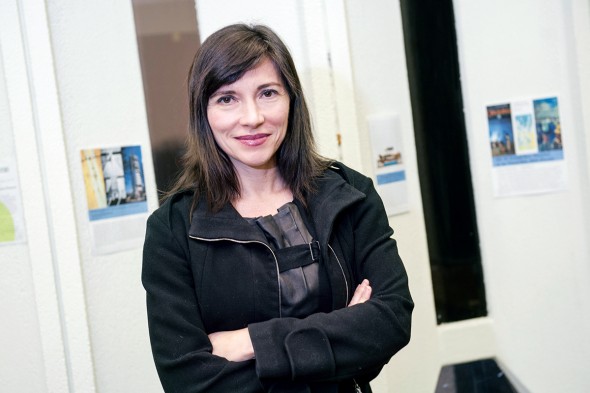Translating, transforming visual concepts
The Researcher of the Year award recognizes 10 UIC scientists who are advancing knowledge in their fields. The Distinguished Researcher Award honors five researchers with a record of outstanding achievement. The Rising Star Award honors early career researchers who show promise as future leaders.
Esra Akcan says that visual concepts, including those that inspire architecture, are translated from one language to another just as verbal concepts are.
She speaks from experience.
Akcan has written extensively on architecture in her native Turkey, where she earned her architecture degree. Her articles have been translated into French, German, Greek and Swedish.
While working on her dissertation at Columbia University, she published (Land)Fill Istanbul, a whimsical illustrated tale in which the city slowly sinks underwater because of ill-advised policies, leaving only historians behind. Its English text is translated line-by-line into Turkish.
A translation is not a secondhand copy, emphasized Akcan, associate professor and director of graduate studies in art history in the College of Architecture, Design and the Arts.
“I define translation as the transformation that happens during transportation — of images, ideas, people, objects, technologies, information.
“I think the history of architecture could be written by tracing the circulation of these and seeing how they get transformed in different locations,” Akcan said.
As an example, she cites the idea of the garden city, with belts of parkland or farmland that offer a connection with nature. It began with an 1898 book by English theorist Ebenezer Howard, who incorporated ideas from his time spent in America. Translations made the book influential in Germany, then in Turkey during its modernization. Each culture transformed the garden city theory in some ways.
“So it connects Germany and Turkey in a unique way, but one is not a reflection of the other,” she said.
Akcan is working on a book with the working title Open Architecture and the Non-Citizen about the 1980s urban renewal of Kreuzberg, a Turkish immigrant neighborhood in Berlin. A building exhibition there, called IBA, featured design competitions for public housing and schools that attracted influential architects from all over Europe and North America.
“I’m treating IBA as a microcosm of the architectural discourse of the ’70s and ’80s, because so much diverse architectural intelligence was put into that neighborhood during those 10 years,” she said.
“I’m also treating it as a moment in the history of public housing. And the third focus is on immigration policies and architecture, because there were some discriminatory housing regulations implanted through that project.
“I’m also theorizing open architecture as a translation of the ethics of hospitality, as it’s been discussed as a way of opening oneself to a stranger.”

